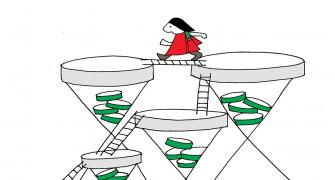Besides high portfolio yield, investors may enjoy capital gains in debt funds in 2023 as bonds rally in anticipation of rate cuts.

Most categories of debt funds offered low single-digit returns in 2022.
The outlook for 2023, however, is brighter.
Besides gaining from higher portfolio yields, investors could also get the benefit of capital gains in 2023.
Low returns in 2022
Supply disruptions caused by the Russia-Ukraine war led to commodity, including crude, prices rising sharply.
A lot of pent-up demand came in as economies opened up.
Supply and demand pressures combined to drive inflation up.
Central banks across the globe, including the Reserve Bank of India, responded by raising interest rates rapidly.
"The effective overnight lending rate, which stood at 3.35 per cent in March, moved all the way up to 6.5 per cent. Thus, interest rates have risen by more than 300 basis points (bps) within six months. It is this sharp rise in interest rates that has caused past returns in debt funds to look poor," says Murthy Nagarajan, head-fixed income, Tata Mutual Fund.
Bright outlook for 2023
The yield to maturity (YTM) of most debt fund categories is high.
"The accrual alone is at around 7 per cent plus right now," says Murthy.
According to Anand Nevatia, fund manager, Trust Mutual Fund, "AAA quality corporate bonds--of one year and higher maturity -- are offering 7.5 per cent, a very good rate of return."
The central bank is close to the end of its rate hike cycle.
"Interest rates are likely to be stable for some time and then decline," says Mahendra Jajoo, head of fixed income, Mirae Asset Global Investments.
Besides high portfolio yield, investors may enjoy capital gains in debt funds in 2023 as bonds rally in anticipation of rate cuts.
The right segment
According to Nevatia, the two- to five-year segment of the yield curve is the most attractive right now.
He enumerates four reasons. One, the accrual yield is high here. Two, there is still some uncertainty vis-a-vis inflation as core inflation remains sticky. Inflation is also pervasive.
"This time inflation is being driven by a majority of the constituents of the Consumer Price Index (CPI)-based inflation, so it may not decline in a hurry," says Nevatia.
Three, since the RBI started hiking rates, the bulk of the reaction has occurred at the shorter end of the yield curve -- up to three-four years.
"While the one-year rate has moved up by about 250 bps, the 10-year rate has hardly moved by 60-70 bps. Some correction can still occur at the longer end of the curve," says Nevatia.
Four, there is no incentive to take duration risk right now.
"Whether you invest in a three-year or a 10-year portfolio, you will get a similar portfolio yield," says Nevatia.
Hence, according to him, the two- to five-year part of the yield curve is most attractive currently.
Investors with a six-month to one-year horizon may opt for a low-duration fund.
Those with a one- to three-year horizon may opt for short-duration debt funds and corporate bond funds.
Some tactical exposure to money market funds may also be taken.
"Whenever they feel it's a good time to take duration exposure, they can move from the money market fund into a gilt fund," says Nevatia.
Enter long-duration funds later
CPI inflation is expected to move into the 5-5.5 per cent band in 2023.
As it does so, the market will start anticipating rate cuts.
Says Murthy: "From June-July, the market will begin to drive yields lower in anticipation of rate cuts. So, investors can expect accrual plus price appreciation."
Nevatia says investors should take duration bets later in 2023 once the inflation scenario becomes clearer, it is apparent that interest rates have peaked, and the RBI moves into an easing stance.
Currently, the 10-year yield is at around 7.32 per cent.
Nevatia suggests investors start allocating to longer-duration funds once the yield moves to 7.4-7.5 per cent.
They may go for a 10-15 per cent allocation of their debt fund portfolio to these funds.
Jajoo suggests that investors who have an investment horizon of three-five years may invest in a target maturity fund of matching maturity.











